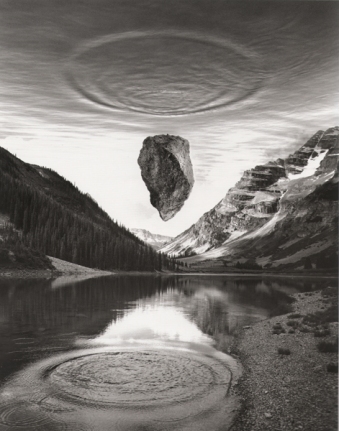We’re photographers. We know images aren’t real. Don’t we?
I mean, we know the image at right by Jerry Uelsmann (Untitled, 1991) doesn’t capture “the real”… logic tells us such a bizarre and implausible juxtaposition of object and situation must be a construction, right?
But what about “straight” images? Do they capture the real?
All images, after all, are constructions resulting from a range of authorial choices – decisions about camera angle, framing, cropping, focus, film stock, lighting, background, proximity, facial expressions and clothing, for example, all add to the meaning of an image.
Yet, despite their lack of objectivity, photographs are seen to have a special connection with the real, and are the standard against which the realism of all other images is measured.
In their early years, photographs were seen to be free of the selective discriminations of the photographer’s eye, hand or visual memory because they were mechanically produced. The presumed power of accurate, dispassionate recording appeared to displace the artist’s compositional creativity, and photography was deemed by many to fall outside the realm of art.
Even though we know, intellectually, that photographs are not “real”, don’t tell “the truth”, but rather are constructions, still most of us believe photographs have the power to signify “truth” and thereby invest them with meaning.
We tend to see photographs as faithful recordings – as though something about the world has been revealed to us, that the photograph shows us the way things really look.
And we read photographs differently from paintings, as demonstrated by the fact that the most controversial works of art in recent times have been photographs, not paintings.

Sally Mann – Jessie at 5 (1987)
The Immediate Family series of photographs by Sally Mann featured her half-clothed or naked children and sparked outrage in some quarters precisely because they were photographs, because the images chronicled something that was “real”.
Similarly, a 2008 Bill Henson exhibition featuring photographs of a naked thirteen-year old girl provoked heated debate in Australia and beyond.
While some paintings have certainly shown overt sexuality in their representation of girls, we see these works as constructs by the painters concerned, rather than as records of something “real”.
 The 1932 image Behind the Gare St Lazare by Henri Cartier-Bresson (at right) portrays a man leaping over a puddle, while a corresponding scene is repeated on circus posters in the background which are also reflected in the puddle. As a photograph, we’re likely to read the scene captured as a fortuitous coup of impeccable timing, but as a painting, the composition would seem contrived and much less intriguing!
The 1932 image Behind the Gare St Lazare by Henri Cartier-Bresson (at right) portrays a man leaping over a puddle, while a corresponding scene is repeated on circus posters in the background which are also reflected in the puddle. As a photograph, we’re likely to read the scene captured as a fortuitous coup of impeccable timing, but as a painting, the composition would seem contrived and much less intriguing!
While a painting delights us because we know it’s a construction of paint and a product of human artistic intervention, the distinctive detail provided by a photograph delights us because we see it as “real”.
How do you feel about photography’s special association with the real?
Related post: Is it ethical to shoot reportage images with iPhone apps?
























